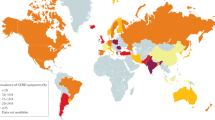Abstract
Gastro-oesophageal reflux disease (GERD) covers a broad range of signs and symptoms arising from the orad movement of gastric contents into the oesophagus, oropharynx, larynx or airway. Most commonly, contact with and damage to the oesophageal epithelium by acidic refluxate causes micro or macroscopic defects leading to the symptom of heartburn. However, GERD can also give rise to extra-oesophageal manifestations such as pharyngitis, laryngitis, asthma and other disorders, identifiable as acid-mediated events by a favorable response to acid suppression.
Only one-third of individuals with heartburn have endoscopic evidence of erosive oesophagitis; the remainder have endoscopy-negative or non-erosive reflux disease (NERD). Improved investigative technologies are increasing our understanding of the pathophysiology of NERD. For example, although a number of microscopic abnormalities have been identified, oesophageal damage in NERD has been shown to be characterized by the presence of ‘dilated intercellular spaces’ within oesophageal stratified squamous epithelium. Dilated intercellular spaces that reflect damage to the intercellular junctions enable levels of acidity that would be considered innocuous when present in the oesophageal lumen to initiate pathological responses within oesophageal nociceptors when present within the intercellular spaces. This effectively gives rise to the symptom of heartburn.
Excessive acidity within the intercellular spaces in NERD also presages its evolution to erosive disease, the latter through inflammation-mediated disruption of the antireflux and luminal clearance mechanisms. Support for this scenario is evident by the ability of effective acid control with proton pump inhibitors both to control symptoms, and lead to resolution of dilated intercellular spaces in patients with both erosive and non-erosive disease. This article examines these concepts and how they shape our current understanding of GERD.
Similar content being viewed by others
References
Pope CEII. Gastroesophageal reflux disease. In: Sleisenger MH, Fordtran JS, editors. Gastrointestinal disease; pathophysiology, diagnosis, management, 2nd ed. Philadelphia: WB Saunders Company; 1978. pp. 541–68
Barlow WJ, Orlando RC. The pathogenesis of heartburn in nonerosive reflux disease: a unifying hypothesis. Gastroenterology 2005; 128: 771–8
Liu M, Willmott NJ, Michael GJ, et al. Differential pH and capsaicin responses of Griffonia simplicifolia IB4 (IB4)-positive and IB4-negative small sensory neurons. Neuroscience 2004; 127: 659–72
Orlando RC. Pathophysiology of gastroesophageal reflux disease: offensive factors and tissue resistance. In: Orlando RC, editor. Gastroesophageal reflux disease. New York: Marcel Dekker, Inc; 2000. pp. 165–92
Bell NJ, Burget D, Howden CW, et al. Appropriate acid suppression for the management of gastro-oesophageal reflux disease. Digestion 1992; 51 suppl. 1: 59–67
Calabrese C, Bortolotti M, Fabbri A, et al. Reversibility of GERD ultrastructural alterations and relief of symptoms after omeprazole treatment. Am J Gastroenterol 2005; 100: 537–42
Fass R, Ofman JJ. Gastroesophageal reflux disease — should we adopt a new conceptual framework? Am J Gastroenterol 2002; 97: 1901–9
Pace F, Bollani S, Molteni P, et al. Natural history of gastro-oesophageal reflux disease without oesophagitis (NERD) — a reappraisal 10 years on. Dig Liver Dis 2004; 36: 111–5
So JB, Zeitels SM, Rattner DW. Outcomes of atypical symptoms attributed to gastroesophageal reflux treated by laparoscopic fundoplication. Surgery 1998; 124: 28–32
Author information
Authors and Affiliations
Corresponding author
Additional information
Dr Orlando has or has had in the recent past relationships (consulting, lecture bureau, research support, stock ownership) with the following companies: TAP Pharmaceuticals, AstraZeneca, Novartis, Proctor and Gamble, Santarus, Sirna, Boston Scientific, Pfizer, Merck.
Rights and permissions
About this article
Cite this article
Orlando, R.C. Current Understanding of the Mechanisms of Gastro-oesophageal Reflux Disease. Drugs 66 (Suppl 1), 1–5 (2006). https://doi.org/10.2165/00003495-200666001-00002
Published:
Issue Date:
DOI: https://doi.org/10.2165/00003495-200666001-00002




